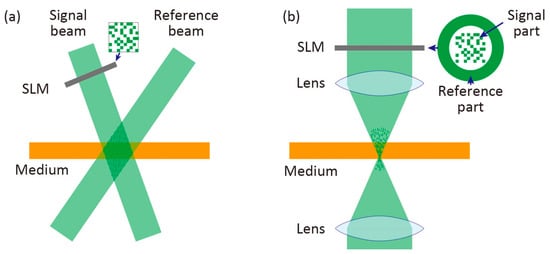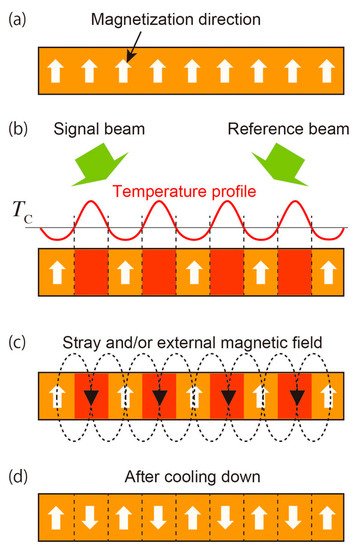
| Version | Summary | Created by | Modification | Content Size | Created at | Operation |
|---|---|---|---|---|---|---|
| 1 | Yuichi Nakamura | + 2129 word(s) | 2129 | 2021-06-03 07:37:04 | | | |
| 2 | Nora Tang | Meta information modification | 2129 | 2021-06-24 05:52:43 | | |
Video Upload Options
The principle of magnetic holograms and its application to holographic memory are reviewed. A magnetic hologram was recorded through a thermomagnetic recording as a difference in magnetization direction and reconstructed with the magneto-optical effect. To achieve a bright reconstruction image, it is important to record deep magnetic fringes on the materials with large Faraday rotation coefficients. This technique was applied to the holographic memory using transparent magnetic garnets as a recording material. The first reconstruction image was dark and noisy, but improvements in the recording conditions resulted in error-free recording and reconstruction of the magnetic hologram. To form deep magnetic fringes, insertion of heat dissipation (HD) layers into recording layer was proposed. It was found that this HD multilayer medium showed diffraction efficiency higher than that of a single layer medium, and error-free recording and reconstruction were also achieved, using magnetic assisted recording. These results suggest that HD multilayer media have potential applications in recording media of magnetic holographic data storage. In future, a high recording density technique, such as multiple recording, should be developed.
1. Introduction

2. Principles of Recording and Reconstruction of Magnetic Holography
2.1. Recording of Magnetic Hologram

2.2. Reconstruction from Magnetic Hologram

3. Conclusions
References
- Mikaeliane, A.L.; Bobrinev, V.I. Holographic memory devices. Opto Electron. 1970, 2, 193–199.
- Rajchman, J.A. An Optical Read-Write Mass Memory. Appl. Opt. 1970, 9, 2269–2271.
- Sakaguchi, M.; Nishida, N.; Nemoto, T. A New Associative Memory System Utilizing Holography. IEEE Trans. Comput. 1970, C-19, 1174–1181.
- Takeda, Y. Hologram memory with high quality and high information storage density. Jpn. J. Appl. Phys. 1972, 11, 656–665.
- D’auria, L.; Huignard, J.; Spitz, E. Holographic read-write memory and capacity enhancement by 3-Dstorage. IEEE Trans. Magn. 1973, 9, 83–94.
- Nomura, H.; Okoshi, T. Storage density limitation of a volume-type hologram memory: Theory. Appl. Opt. 1976, 15, 550–555.
- Hong, J.H.; McMichael, I.; Chang, T.V.; Christian, Q.; Paek, E.G. Volume holographic memory systems: Techniques and architectures. Opt. Eng. 1995, 34, 2193–2203.
- Rakuljic, G.A.; Leyva, V.; Yariv, A. Optical data storage using orthogonal wavelength multiplexed volume holograms. Opt. Lett. 1992, 17, 1471–1473.
- Li, H.-Y.S.; Psaltis, D. Three-dimensional holographic disks. Appl. Opt. 1994, 33, 3764–3774.
- Pu, A.; Psaltis, D. High-density recording in photopolymer-based holographic three-dimensional disks. Appl. Opt. 1996, 35, 2389–2398.
- Orlov, S.S.; Phillips, W.; Bjornson, E.; Takashima, Y.; Sundaram, P.; Hesselink, L.; Okas, R.; Kwan, D.; Snyder, R. High-transfer-rate high-capacity holographic disk data-storage system. Appl. Opt. 2004, 43, 4902–4914.
- Horimai, H.; Tan, X. Holographic versatile disc system. Proc. SPIE 2005, 5939, 593901.
- Horimai, H.; Tan, X.; Li, J.; Suzuki, K. Wavelength margin analysis in advanced collinear holography. Jpn. J. Appl. Phys. 2005, 44, 3493–3494.
- Horimai, H.; Tan, X.; Li, J. Collinear holography. Appl. Opt. 2005, 44, 2575–2579.
- Horimai, H.; Tan, X. Advanced collinear holography. Opt. Rev. 2005, 12, 90–92.
- Horimai, H.; Tan, X. Collinear technology for a holographic versatile disk. Appl. Opt. 2006, 45, 910–914.
- Horimai, H.; Tan, X. Holographic information storage system: Today and future. IEEE Trans. Magn. 2007, 43, 943–947.
- Mezrich, R.S. Curie-point writing of magnetic holograms on MnBi. Appl. Phys. Lett. 1969, 14, 132–134.
- Mayer, L. Curie-Point Writing on Magnetic films. J. Appl. Phys. 1958, 29, 1003.
- Fan, G.; Pennington, K.; Greiner, J.H. Magneto-Optic Hologram. J. Appl. Phys. 1969, 40, 974–975.
- Mezrich, R.S. Magnetic Holography. Appl. Opt. 1970, 9, 2275–2279.
- Mezrich, R.S. Reconstruction Effects in Magnetic Holography. IEEE Trans. Magn. 1970, 6, 537–541.
- Hascal, H.M. Polarization and Efficiency in Magnetic Holography. IEEE Trans. Magn. 1970, 6, 542–545.
- Nakamura, Y.; Takagi, H.; Lim, P.B.; Inoue, M. Magnetic volumetric hologram memory with magnetic garnet. Opt. Express 2014, 22, 16439–16444.
- Nakamura, Y.; Takagi, H.; Lim, P.B.; Inoue, M. Effect of recording condition on the diffraction efficiency of magnetic hologram with magnetic garnet films. J. Appl. Phys. 2014, 116, 103106.
- Isogai, R.; Sagara, N.; Goto, T.; Nakamura, Y.; Lim, P.B.; Inoue, M. Diffraction efficiency of volumetric magnetic holograms with Magnetophotonic crystals. J. Mag. Soc. Jpn. 2014, 38, 119–122.
- Isogai, R.; Goto, T.; Takagi, H.; Nakamura, Y.; Lim, P.B.; Inoue, M. Effect of structure and properties of magnetic material on diffraction efficiency of magnetophotonic crystal media for magnetic volumetric holography. J. Mag. Soc. Jpn. 2015, 39, 33–36.
- Isogai, R.; Suzuki, S.; Nakamura, K.; Nakamura, Y.; Takagi, H.; Goto, T.; Lim, P.B.; Inoue, M. Collinear volumetric magnetic holography with magnetophotonic microcavities. Opt. Express 2015, 23, 13153–13158.
- Isogai, R.; Nakamura, Y.; Takagi, H.; Goto, T.; Lim, P.B.; Inoue, M. Thermomagnetic writing into magnetophotonic microcavities controlling thermal diffusion for volumetric magnetic holography. Opt. Express 2016, 24, 522–527.
- Nakamura, Y.; Shirakashi, Z.; Takagi, H.; Lim, P.B.; Goto, T.; Uchida, H.; Inoue, M. Error-free reconstruction of magnetic hologram via improvement of recording conditions in collinear optical system. Opt. Express 2017, 25, 15349–15357.
- Shirakashi, Z.; Goto, T.; Takagi, H.; Nakamura, Y.; Lim, P.B.; Uchida, H.; Inoue, M. Reconstruction of non-error magnetic hologram data by magnetic assist recording. Sci. Rep. 2017, 7, 12835.
- Nakamura, Y.; Lim, P.B.; Goto, T.; Uchida, H.; Inoue, M. Recording and reconstruction of volumetric magnetic hologram using multilayer medium with heat dissipation layers. Opt. Express 2019, 27, 27573–27579.
- Nakamura, Y.; Lim, P.B.; Goto, T.; Uchida, H.; Inoue, M. Development of Heat Dissipation Multilayer Media for Volumetric Magnetic Hologram Memory. Appl. Sci. 2019, 9, 1738.
- Nakamura, Y.; Lim, P.B.; Goto, T.; Uchida, H.; Inoue, M. Development of heat dissipation multilayer media for magnetic hologram memory. Electron. Comm. Jpn. 2020, 103, 22–29.
- Chen, D.; Otto, G.N.; Schmit, F.M. MnBi Films for Magnetooptic Recording. IEEE Trans. Magn. 1973, 9, 66–83.
- Lee, T.C.; Chen, D. Writing characteristics of MnBi films for Holographic recording. Appl. Phys. Lett. 1971, 19, 62–65.
- Tanaka, M.; Ito, T.; Nishimura, Y. Diffraction Efficiency of Magnetic Hologram. IEEE Trans. Magn. 1972, 8, 523–525.
- Aagard, R.L.; Lee, T.C.; Chen, D. Advanced optical storage techniques for computers. Appl. Opt. 1972, 11, 2133–2139.




